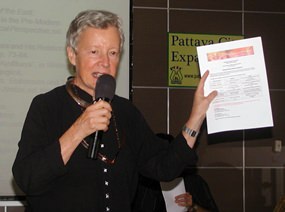Japanese Samurai served as bodyguards for the King of Ayutthaya. This was one of the facts mentioned by John Toomey during his lecture on the “Samurai of Siam.” On Sunday, September 1, the Pattaya City Expats Club in conjunction with the National Museum Volunteers (NMV) Pattaya group had as its guest speaker NMV member and lecturer John Toomey.
He is well known for his vast knowledge of and passionate interest in Asian art and history. During the Ayutthaya period, the colony was home to about 1,000 Japanese citizens, and was headed by a Japanese chief. Its most prominent chief was Yamada Nagamasa, also known as the Samurai of Siam.
 On Sunday, 1st of September, the Pattaya City Expats Club in conjunction with the National Museum Volunteers (NMV) Pattaya group had as its guest speaker NMV member and lecturer John Toomey. He is well known for his vast knowledge of and passionate interest in Asian art and history.
On Sunday, 1st of September, the Pattaya City Expats Club in conjunction with the National Museum Volunteers (NMV) Pattaya group had as its guest speaker NMV member and lecturer John Toomey. He is well known for his vast knowledge of and passionate interest in Asian art and history.
John began by describing events in Japan at the end of the 16th and early part of the 17th century which resulted in many Japanese fleeing Japan to Ayutthaya and other lands in Asia. The Colony’s inhabitants were a combination of traders, Christian converts who had fled their home country following their persecution by Japanese Shoguns of the time, and samurai who, as a result of civil war, no longer had a master to serve.
 Member Al Serrato reminds members of the activities of the Spanish speaking special interest group.
Member Al Serrato reminds members of the activities of the Spanish speaking special interest group.
Many of the Japanese were accepted into the small army of personal bodyguards of the King because of their fighting skills and the quality of their swords. The Japanese volunteered to be bodyguards because they were grateful the King let them stay. John explained how Yamada Nagamasa joined the community and rose to power and going from low Thai nobility rank to a senior noble becoming the governor of Nakhon Si Thammarat province, located on the Malay Peninsula in present-day southern Thailand. Yamada was born in 1590, in Japan, and died in 1630, in Thailand, with some speculation that he was poisoned.
There was a history of strong trade ties between Japan and Ayutthaya including communication between the King and the Shogun of Japan. John described the “Red Seal” ships noting that the name came from the document they were provided by the Shogun’s government allowing them to trade with Japan. Much of this trade involved the export of deer-hide to Japan and jars that the Japanese prized for the storing of tea leaves (used in the important Japanese Tea Ceremonies). Also, you can’t really blame the Shogun of Japan for a comment made in one of his letters to the King. After all, he’d never made the trip to Southeast Asia. The Shogun’s ignorance of the climate of Southeast Asia was demonstrated when he wrote a letter to the King fostering trade relations in which he said, “Take care of your health in the wintry season.”
When he came to Ayutthaya, Yamada Nagamasa established himself as a trustworthy merchant, warrior, and leader of the Japanese colony. He supported the military campaigns of the King Songtham, at the head of a Japanese army flying the Japanese flag. Yamada may have been a “masterless samurai,” but this is not known for sure. If so, he would have had to become a samurai in Japan before the age of 21.
 Margot Weinmann of the National Museum Volunteers invites PCEC members to their upcoming lecture series.
Margot Weinmann of the National Museum Volunteers invites PCEC members to their upcoming lecture series.
After Yamada’s death, the authorities in Ayutthaya, worried that the Japanese had become too involved in the Thai economy and were gaining too much strength, ordered that every Japanese person be killed. So, the people in the Japanese colony went through good times and bad, but, as John said, “They were caught between the devil and the deep blue sea” because they were also not allowed to return to Japan on penalty of death. Some fled to Cambodia and others were killed. Eventually, however, the Japanese who remained in Ayutthaya (that were not killed) were given tracts of land.
John said that Yamada Nagamasa is a well-known historical figure in Japan and there have been 20 books and novels written about him as well as a Thai movie. You can learn more about Yamada Nagamasa by visiting http://en.wikipedia.org/wiki/Yamada_Nagamasa and www.simandan.com/?p=6472. Also, you can view the movie on You Tube at www.youtube.com/watch? v=JI0D4vq2KRY (has English subtitles). If you missed the free lecture at the PCEC, NMV in Bangkok will host this lecture on October 1. John’s lecture will start at 10 a.m. in the museum’s auditorium. Admission fee is 200 baht for nonmembers and 100 for members. Call 084-942-1012 or email [email protected] for more information.
After John’s presentation Master of Ceremonies Richard Silverberg brought everyone up to date on upcoming events and then called on Roy Albiston to conduct the interesting and informative open forum where questions are asked and answered about Expat living in Thailand.
For more information on the many activities of the PCEC, visit their website at www.pattayacityexpatsclub.com.




